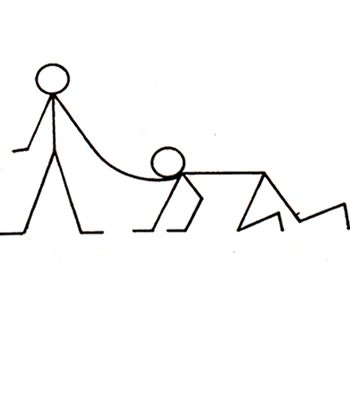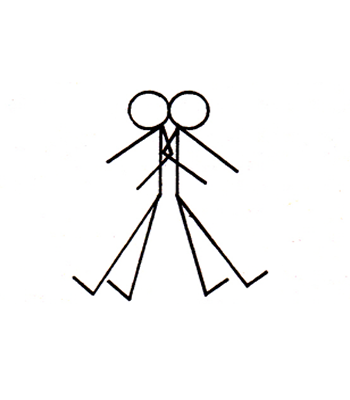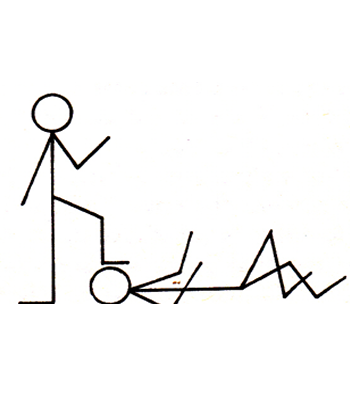 |
 |
R E B U I L D I N G O N L I N E C O U R S E
SECTION ELEVEN-
![]()
If you say you can trust a man or woman in a relationship then you are saying more about yourself than about the man or woman. Love based relationships after divorce can be attempts to heal wounds and so so many of them are transitional or short term. In you new relationship with other you may be reworking and improving the way you got along with your parents. By building a basic level of trust within yourself, you can experience satisfying emotionally closer and intimate relationships.
I was doing fine and enjoying myself. Then he said 'I love you.' I panikced and told him to get up, put on his clothers, and go home. Ann
At this stage in the recovery process you may see people walk a distance from potential partners. They are like wild animal that come close, hoping to get some food, yet run for cover the minute your move toward them. These people talk about relationships a great deal of the time, and they seem to want to date and to be with potential partners. But as soon as someone makes a move toward them, they run and shout 'stay away!' They are still serverly wounded by 'love'.
The idea for some that another relationship will 'prove you are okay' leads many people to start immediately to find a new one and only. You have probably seen the poster 'you have to kiss a lot of frogs before you find a prince'. It seems healthier to conclude: 'You have to kiss a lot of frogs before you become a prinz with prinz being a non sexist word for princess and prince'.
The divorce process can be viewed in two major steps. The first is learning to be a single person again ready to face life alone with the rubble of the past cleared away. The second step is learning to love again after you have rebuilt your strength to carry the burden of a long term committed relationship. So if you complete the first step then step two will be easier.
Here is an exercise that I have carried out at this stage with seminar groups for over twenty years and it derived from the work of family therapist Virgina Satir which she terms body sculpting. I devide the group into pairs but you might like to do this with a good friendto help. The diagrammes illustrate different body positions which show various types of relationships that people have. Let's look at the body sculptures and consider the feelings beneath each of these 'styles' of relating.
1. A-Frame Depndency Relationship

In the dependency relationship, two people lean on each other themselves Dependency upon another person sometimes feels good, but it is somewhat confining. When one person wants to move, change, or grow, it upsets the other who is leaning on them. Try this sculpture with another person and then put into words some of the feelings that you have while you are assuming this position.
2. Smothering Relationship

Here is a position quite freqnetly seen in teenage relationships. The vocabulary of this relationnship is, 'I can't live without you. I want to spend th rest of my life with you. I will devote myself completely to making you happy. It feles so good to be close to you.' Many lovers start out by smothering, then gradually release the strangle hold on each other to allow more room for growth. This smothering pattern may be particularly significant during the honeymoon stage of new love. The smothering relationship feels good for a while, but eventually the partners begin to feel trapped.
3. Pedestal relationship

This 'worshipful' relationship says, 'I love you not for who you are, but for who I think you ar. I have an idealized image of you and I'd like to have you live up to that image.' It is very precarious on top of the pedestal because there are so many expectations to live up to. You can see the problems of communication here. IN love with the person's idealised image, the worshipper is lookcing up to and tring to communicate wtih that image instead of the real person. There is a great deal of emotional distancing inherenet in this relationship, and it is difficult for the two people to become close.
4. Master / Slave Relationship

The master acts and is treated according to these ideas: 'I'm the head of the family. I'm the boss. I 'll make the decisions around here. Do not assume that this relationship necessarily places the males as the boss and heard of the family i. There are females who are masters, making all the decision for their families.
In most relationships one of the partners has a personality which is at least a little stronger than the other, and that is not necessarily bad. When the relationship becomes rigid and inflexible, and one person is set up to make virtually all of th decisions, emotional distancing and inequality take place. Maintating one person as amaste and th other as slave tends to take a great deal of emotinal energy, and often results in a power struggle that interferes with the communciation and intimacy of the relationship.
5. Boarding House: Back to Back Relationship.

Linked by their elbows, these tow have some sort of contact or agreement that they are going to live together. There is no communcation in this relationship. The typical thing is for people to come home and sit down and watch TV while they are eating, then retire to their own living habits for the remainder of the evening. There is no expression of love toward each other. Notice as you try this position, that when on person moves foward, changes (i.e. grows and matures), the other person is linked to that change. Back to back is a very confining relationship. Many perople recongise this as the pattern that existed just before their relationship ended.
6.Martyr Relationship

Here is the person who completely sacrifices by trying to serve others. Always doing things for other people, never taking time for self, the martye goes about 'on hands and knees.' But do not let the lowly psoture fool you! The martyr position is very controlling. Note that when the person on hands and knees moves, the other person who has a foot on the martyr is thrown off balance. How does the martyr gain control? You guessed it- through guilt. How can you be angry at the person who is doing everything for you, who is taking care of your completely? The martyr is very efficient at controlling people. It is very difficult to live with a martyr because you feel too guilty to express your own needs and angry feelings. Perhaps you have a martyr parent, and can recognise ways of dealing with that parent by understanding the martyr relationship.
7. Health Love Relationship

Two people who are whole and complete have ahppiness within themselves. Standing upright, not leaning on or tangled up with a the other person, they are able to live their own lives. They have an abundance of life to share with the other person. They choose to stay together because they are free to be invidivduals who are sharing their lives together. They can come close together and choose the smothering position temporarily; they can walk hand in hand as they might do in parenting their children; they can move apart and have their own careers, their wown lives, and their own friends. Their choice to stay together is out of love for each other rather than needing to stay together because of some unmet emotional needs. The healthy love rlationship gives both people the space to grow and become themselves.
Again let me urge you to try these different positions with a very good friend and see how they feel. Speak or write about the feeligns that you expereinced. Which of these positions describes your past realtionshp? Many people over the years in my seminars stated that they thought their relationships went through almost all of the unhealthy body positions!
Did you discover the cause of your divorce from the body sculpting? They unhealthy relationships seem to suggest a half person looking for another half person so as you become more of a whole person your chance of developing a healthy, healing relationship is greatly increased.
We tend to act out our internal feelings in our relationships so if you are angry, you probably express anger in your relationships. If you are lonely, you tend to be possessive in the relationship in order to keep the person from leaving you and making you lonely agin. If you are in deep emotional pain, you will likely have a relationship full of pain. If you have a wounded feeling then you distance others to avoid bumping such a wounded heart.
Many of us seek relationships with people who have qualities we are missing in ourselves. If you are introverted and wnat to be more comforable around people you marry an extrovert. Lacking confidence, you marry a person who exudes confidence. To meet your need to feel guilty, you develop a relationship with someone who will make you feel guilty.
And of course, the coin also has a positive side. If you are happy, confident, and feel loveable, you marry to act out those feelings in your relationship. We can learn much about ourselves by looking at our relationshuips. What feelings are you expressing your relationips? Is there a pattern? i.e. do you always bring home a stray cat????? Do your relationsiosnhhips reflect good feelings with or do tyhey reflect neediness? Another major factor in our relationship styles is one I've mentioned beore; the interaction we had with our parents. Each of us learned how to respond to love, anger, rejection, and intimacy from our parents or adults close to us in our child world. If your these adults fought, then you are likely to have a very tough time with fights. If these adults were cold and untouching, then you may find it difficult to touch and handle warm emotios. Many a marriage is not satisfactory because the partners are interacting like these adults did.
Jeff told me, 'Marriage may be like a pot of stew. If you don't make it right the first marriage, you keep doing it over until you get it right. In my first marriage, I was acting out the unproductive patterns I learned as a child. I didn't change internally after my divorce, so I continued to act out those patterns in my second marriage!'
After divorce we often regress and interact the way we did earlier in life. This can be positive: becoming a healthy balanced person emotinally is like climbing the slide in the playground. You progress so far then lose your grip and slide back down. Then the next time you are able to climb to a higher point. In their relationships after divorce, many people are reworking the patterns of interaction they learned from adults in the childhood world in order to make those patterns more productive.
So the problem of trust is largely internal rather than external and understanding your past is helpful in understanding who you are now. Becoming aware of ourselves, our patterns of interaction, and out methods of dealing with relating to others allows us choices.
So now to rebuilding. 'Where do I meet someone?' is the next questions and the answer is right where you are now. People go to ars, singles groups, classes in their attempts to meet people but take care the bar scene for example typically includes many lonely people who cannot relate until they are slightly under the influence. And the bar hoppers are often game players out to practice and improve their games frequently with sex being the goal of the game. Singles groups, too, have a certain amount of desperation and lonliness.
This question 'where do I meet someone' often indicates that you are looking for a committed, long term partner. Perhaps somewhat desperate and senidn otu desperate vibrations with body language, vocaularly and the look in your eyes which tend to drive people away. A colleague many years ago said that when you are hungry and someone walks up to you they can be left feeling like the main meal.
We are nearing the end of our work now so take care not to rush as this particular buidling block must be securely in place before you proceed.
- I can trust men and women to whom I would be attracted to
- I have begun to understand that men and women are much more alike than different in their responses to feelings such as love, hate, intimacy and fear.
- I can trust myself with my feelings.
- I trust my feelings enough to act on them.
- I am not afraid of becoming emotionally close to a potential partner.
- I am ware of the ways that I distance people.
- I am building relationships that will help me to heal.
- I am building healing and trusting relationships with friends of both sexes.
- I communicate with others where I am emotionally rather than giving mixed messages.
- I understand that not everyone is capable of being trusted.
- I am capable of trusting someone when it is appropriate.
- I want to heal and expereince intimacy again.
- I am trying to live in the present in my relationships.
- I realise that many of the early relationships after my divorce may be short term.
- I am taking risks in my relationships by exposing my true feelings and thoughts.
- I am truly interested in the friends around me rather than desperately looking for another relationship.
![]()

Related Websites
(c) Steven Warren 1996 - 2014. All rights reserved. webmaster@stevenwarren.co.uk Official Website.